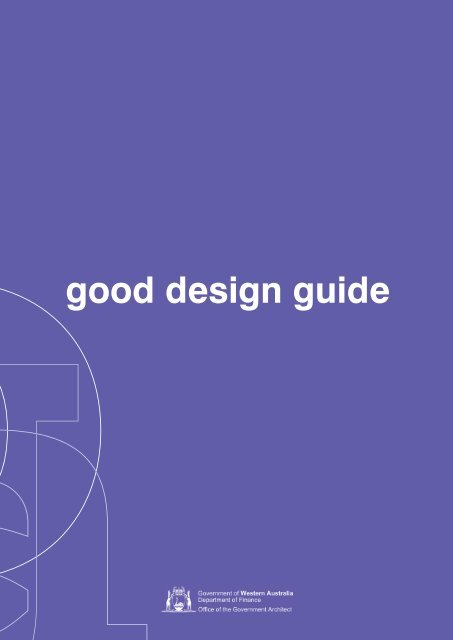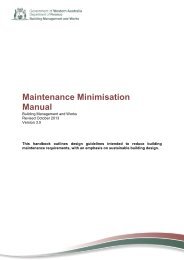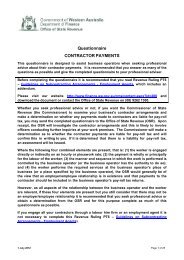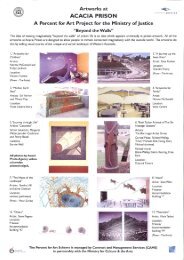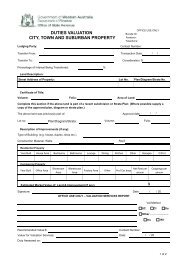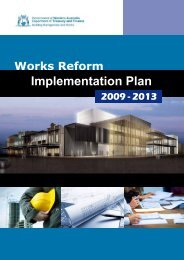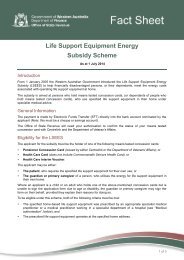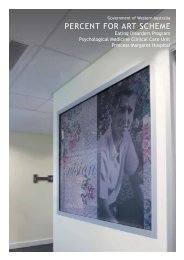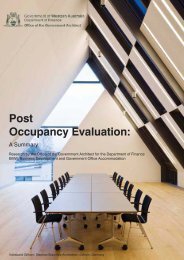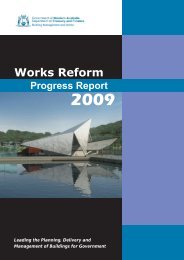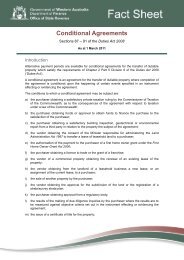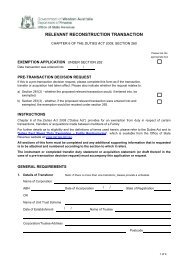Good Design Guide.indd - Department of Finance
Good Design Guide.indd - Department of Finance
Good Design Guide.indd - Department of Finance
- No tags were found...
Create successful ePaper yourself
Turn your PDF publications into a flip-book with our unique Google optimized e-Paper software.
good design guide
The <strong>Good</strong> <strong>Design</strong> <strong>Guide</strong> has been prepared by the Western Australian Office <strong>of</strong> the GovernmentArchitect (OGA) as part <strong>of</strong> its role to improve the quality <strong>of</strong> the state’s built environment. This <strong>Guide</strong>is consistent with the objectives <strong>of</strong> the State Government’s built environment policy - ‘Better Placesand Spaces’ - and complements a range <strong>of</strong> design quality initiatives developed by the OGA as part<strong>of</strong> the Policy’s implementation. The Policy can be viewed online at:www.finance.wa.gov.au/betterplacesFebruary 2013Office <strong>of</strong> the Government ArchitectLevel 1, 491 Wellington StreetPerth 6850(08) 6551 2332
good design guide<strong>Good</strong> design results from a clearly discernable approach and must reconcile a number <strong>of</strong> <strong>of</strong>tencompeting priorities - function, budget, site, performance and aesthetics. Well-designed buildings addmore than aesthetic value to the public realm and have the potential to contribute positively to socialinteraction, economic activity, cultural vitality and deliver sound environmental performance.‘Better Places and Spaces -A Built Environment Policy for Western Australia’What is <strong>Good</strong> <strong>Design</strong>?The value <strong>of</strong> good design:Government is committed to improved design quality in itspublic buildings, spaces and infrastructure. <strong>Good</strong> design isabout functionality, performance and build-quality as much asinnovation and creativity. <strong>Good</strong> design means that buildings andspaces function in a way that contributes to the quality <strong>of</strong> life forthose who use them. <strong>Good</strong> design improves the delivery <strong>of</strong> publicservices, gives a sense <strong>of</strong> identity and community, can improveuser health and safety, and help build a sustainable future. <strong>Good</strong>design delivers value-for-money as well as better buildings,particularly when attention is paid to the full costs <strong>of</strong> a building’slifetime.constructiondesignmaintenance +running costsSeeking improved design quality in public buildings and spacesis an important part <strong>of</strong> Government’s commitment to pursuingvalue for money. To understand the true value <strong>of</strong> a project requiresconsideration <strong>of</strong> its ‘whole-life’ performance. Better value formoney will be achieved through sustained improvement in theperformance <strong>of</strong> public buildings, but lowest cost is not the aim.Instead, the best balance <strong>of</strong> quality and whole-life costs to meetuser requirements should guide decision making.Who is responsible for <strong>Good</strong> <strong>Design</strong>?Government (the client and commissioning agency); the deliveryagencies – Buildings Management and Works (BMW) or StrategicProjects (SP); the appointed consultant team and the GovernmentArchitect all have a shared responsibility in ensuring the delivery<strong>of</strong> good public buildings, places and infrastructure. To achievegood design outcomes, design quality needs to be championed,invested in and worked towards. All decision makers involvedin the procurement <strong>of</strong> Government’s public works have a role toplay in ensuring good design outcomes. The first step is to makedesign Quality a priority from the outset <strong>of</strong> a project – equal withTime and Cost – during decision making.operating a public serviceLife time costs <strong>of</strong> public facilities:<strong>Design</strong>: 0.3-0.5%Construction: 2-3%Maintenance: 9-12%Operating Cost: 85%Office <strong>of</strong> Government Commerce/CABE, UK, 2002Office <strong>of</strong> the Government Architect page 1
good design guideWhat is the value <strong>of</strong> <strong>Good</strong> <strong>Design</strong>?Compared to the costs <strong>of</strong> running a public service, both up-frontdesign costs and capital costs are relatively minor. At the sametime, it is through the design process that the largest impact canbe made on future operating and maintenance costs. <strong>Good</strong> designreduces whole-<strong>of</strong>-life costs; creates flexible, adaptable facilitieswhich respond to the need for change; and produces facilities thatare easy and cost effective to manage, clean and maintain. Earlydesign decisions have a significant impact on both the up-frontand ongoing costs <strong>of</strong> all building projects. <strong>Good</strong> design is aboutgetting these decisions right, first time. By focusing on designingwell today, we’re helping to ensure that we pay less tomorrow.As well as financial dividends to government, good designcan deliver a range <strong>of</strong> broader economic, social, cultural andenvironmental benefits to the public. For instance:• <strong>Good</strong> design can enhance productivity and support agenciesto achieve the best outcomes for government and those usingthese services.• <strong>Good</strong> design is inclusive: it results in places where everyonecan participate equally, confidently and independently ineveryday activities.• <strong>Good</strong> design can contribute positively to our sense <strong>of</strong> identityand wellbeing.• <strong>Good</strong> quality spaces and places have the ability to contributetowards improving safety and reducing crime.What is the cost <strong>of</strong> bad design?If there is significant value from good design, there are <strong>of</strong>ten evengreater costs associated with bad design. While it may only be inthe longer term that the benefits <strong>of</strong> good design pay back on theinitial investment, poorly designed schemes can have immediatenegative effects and decline in performance with each year overtheir lifetime. Bad design can lead to facilities needing to bereplaced or significantly refurbished well before initially planned.This imposes a cost on building users, staff, neighbours and thebroader public.The impact <strong>of</strong> bad design is more than a financial one. Poorlydesigned developments can have a detrimental impact on the lives<strong>of</strong> individuals and communities by being unsafe or insecure. Thequality <strong>of</strong> government service delivery can be undermined by poordesign outcomes. Equally poor design can be environmentallyunsustainable and inefficient over its projected life span.Avoiding poor design is a shared responsibility between projectstakeholders and it is important to identify ways in which eachparticipant can contribute to achieving good design outcomes.How do we achieve <strong>Good</strong> <strong>Design</strong>?The role <strong>of</strong> the OGA is to improve the design quality <strong>of</strong> publicbuildings and places in Western Australia on behalf <strong>of</strong> government.To assist in this task the OGA has prepared a comprehensive set <strong>of</strong>guidance – supported by the Western Australian built environmentpolicy ‘Better Places and Spaces’ – to better manage designquality in the procurement <strong>of</strong> public works. The aim <strong>of</strong> the designquality guidance, consistent with the Policy, is to:• Embrace good design as a means <strong>of</strong> achieving value formoney and sustainable development.• Promote the value and benefits <strong>of</strong> excellence in architectureand the built environment.• Generate an understanding and expectation <strong>of</strong> good designacross government and within the community.• Establish parameters for the development <strong>of</strong> well-designedpublic buildings and spaces.• Implement procedures for promoting and facilitating designquality in public works.A series <strong>of</strong> actions have been identified below, that will providethe best opportunity to achieve good design outcomes.Office <strong>of</strong> the Government Architect page 2
good design guideActions for Achieving <strong>Good</strong><strong>Design</strong>:1. Prepare a clear and robust vision, brief and businesscase2. Identify champions <strong>of</strong> good design within key agencies3. Approach investment in public buildings and placesfrom a whole-life perspective4. Employ design quality policies, standards andresearch5. Utilise appropriate procurement processes (whichprioritise design quality)6. Ensure appropriate budgeting and schedulingparameters are determined7. Benchmark design quality aspirations as part <strong>of</strong>business case and brief development8. Utilise consultant selection processes which insist ondesign expertise9. Access expert design review for key projects10. Consider and prioritise good design in decision makingduring project planning and delivery11. Involve stakeholders, facility managers and users inthe design process12. Undertake post-occupancy evaluation <strong>of</strong> projectsReferences:OGC UK Achieving Excellence in Construction – <strong>Design</strong> QualityOGC / CABE UK Improving Standards <strong>of</strong> <strong>Design</strong> in the Procurement <strong>of</strong> Public buildingsComponents <strong>of</strong> the OGAs <strong>Design</strong>Quality GuidanceThe OGAs design quality guidance consists <strong>of</strong> a series <strong>of</strong> initiativesand practical tools to ensure that good design is prioritisedthroughout project planning and delivery. Early consideration <strong>of</strong>design quality is a key success factor in achieving good designoutcomes.<strong>Design</strong> quality guidance has been established in concert withthe <strong>Department</strong> <strong>of</strong> <strong>Finance</strong>’s Building Management and Works(BMW) unit. It aligns with the <strong>Department</strong> <strong>of</strong> Treasury’s StrategicAsset Management (SAM) Framework and other policies andprocedures crucial to good asset planning and delivery. Thisguidance does not represent a new layer <strong>of</strong> process, rather itintegrates essential design quality measures within an existingplanning and delivery armature.The OGAs suite <strong>of</strong> design quality guidance consists <strong>of</strong> thefollowing key elements:• PolicyBetter Places and Spaces – A Built Environment Policy forWestern Australia• OGA <strong>Design</strong> StandardsGeneral <strong>Design</strong> Standard 01 – for all public buildingsEducation <strong>Design</strong> Standard 02 – for secondary schoolsHealth <strong>Design</strong> Standard 03 – for hospitals health campusesJustice <strong>Design</strong> Standard 04 – for courthouses and justicecomplexes• <strong>Design</strong> Guidance<strong>Design</strong> Review <strong>Guide</strong><strong>Design</strong> Review <strong>Guide</strong> for Secondary SchoolsMaster Planning <strong>Guide</strong><strong>Design</strong> Quality in Procurement <strong>Guide</strong>By engaging the right expertise at the right stages <strong>of</strong> a project, theOGAs design quality guidance will assist government in achievinggood design in its projects. For further information contact theOGA directly.Office <strong>of</strong> the Government Architect page 3
Office <strong>of</strong> the Government ArchitectLevel 1, 491 Wellington StreetPerth 6850(08) 6551 2332


